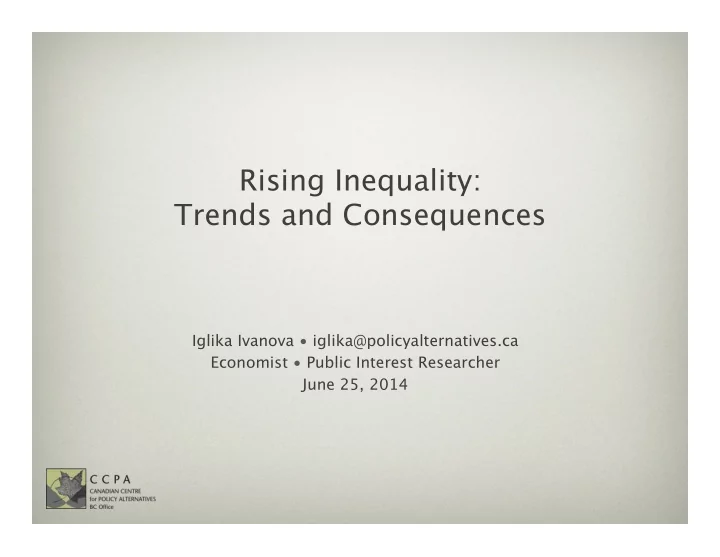

Rising Inequality: Trends and Consequences Iglika Ivanova • iglika@policyalternatives.ca Economist • Public Interest Researcher June 25, 2014
Why we are here: the rise of the 1% Share of income going to the top 1% in the US 20% 15% 10% 5% 0% 1913 1922 1931 1940 1949 1958 1967 1976 1985 1994 2003 2012 Source: Alvaredo, F., A. Atkinson, T. Piketty and E. Saez. The World Top Incomes Database .
Thomas Piketty’s earlier work
Inequality is not just a US problem Share of income going to the top 1% 20% US 15% 10% Canada 5% 0% 1913 1922 1931 1940 1949 1958 1967 1976 1985 1994 2003 2012 Source: Alvaredo, F., A. Atkinson, T. Piketty and E. Saez. The World Top Incomes Database .
Facts about the growing inequality in Canada Income inequality has been on the rise since mid-1980s • but especially since mid-1990s Richest 20% increased their share of total income while • poorest and middle income groups lost share Canadians in the poorest income group saw their incomes • rise, but minimally (from $13,000 in 1976 to $15,100 in 2011) Most income gains have gone to a very small group of • “super-rich” (both before and after the Great Recession) Canada is less unequal than the US, but more unequal • than other rich countries (24 th out of 34 OECD countries)
Who does our economic system work for? Source: Yalnizyan, Armine. 2010. The Rise of Canada’s Richest 1%.
The problem with inequality Social injustice • Bad for the economy (IMF, World Economic Forum, • Conference Board) Reduces social mobility (“American dream”) • Exacerbates many social problems • Bad for the environment and climate • Threatens democracy (“a drift toward oligarchy”) • Undermines social cohesion, political stability •
How is inequality commonly justified? Belief that life outcomes are the results of individual • choices, not societal factors Belief that inequality is necessary to provide incentives to • people to work hard and contribute to society (“the price we pay for growth”) Belief that capitalism has a natural tendency to reduce • inequality at its later stages
Kuznets curve: the mainstream agreement
Piketty challenges the legitimacy of capitalism Argues that capitalism will always create inequality and • naturally ‘drifts to oligarchy’ Exposes rising inequality as unjust and unnecessary • feature of our economic system Shows much of the income distribution in modern society • has no connection to e fg ort, ingenuity and hard work In an economy where the rate of return to wealth is • higher than the rate of economic growth, inherited wealth will always grow faster than earned wealth
The return of a wealth-based society in Europe National capital in Europe, 1870-2010 800% Value of national capital (% national income) 700% Germany 600% France United Kingdom 500% 400% 300% 200% 100% 1870 1890 1910 1930 1950 1970 1990 2010 National capital (sum of public and private capital) is worth between 2 and 3 years of national income in Europe in 1950. Sources and series: see piketty.pse.ens.fr/capital21c Source: Piketty, Thomas. 2014. Capital in the 21 st Century. Figure 4.5
Wealth is growing in importance in the US too National capital in Europe and America, 1870-2010 800% United States 700% Value of national and foreign capital (% national income) Europe 600% 500% 400% 300% 200% 100% 1870 1890 1910 1930 1950 1970 1990 2010 National capital (public and private) is worth 6.5 years of national income in Europe in 1910, vs. 4.5 years in America. Sources and series: see piketty.pse.ens.fr/capital21c. Source: Piketty, Thomas. 2014. Capital in the 21 st Century. Figure 5.2
Wealth is distributed very unequally Richest 20% of American families own 89% of total wealth • Richest 1% of American families own 35% of total wealth • Poorest 40% of American families have more debt than • assets Source: Edward Wol fg (2012) based on 2010 data Richest 20% of Canadian families own 67% of total wealth • Poorest 40% of Canadian families own 2.1% of total wealth • Source: 2012 Survey of Financial Security
Wealth inequality in Europe and the US since 1810 Share of wealth owned by the top 10% 100% 90% 80% 70% 60% 50% 40% 30% 20% 10% 0% 1810 1830 1850 1870 1890 1910 1930 1950 1970 1990 2010 Un#l%the%mid%20th%century,%wealth%inequality%was%higher%in%Europe%than%in%the%United%States.% Sources and series: see piketty.pse.ens.fr/capital21c. Source: Piketty, Thomas. 2014. Capital in the 21 st Century. Figure 10.6
We don’t know enough about wealth inequality
And the Canadian edition
In the meantime for the rest of us… Source: Statistics Canada. 2014. CANSIM Table 202-0101.
Other inequalities compound the problem Men Women Source: Statistics Canada. 2014. CANSIM Table 202-0101.
Unbalanced growth Median income growth for di fg erent income groups in BC 100% 80% Top 1% 60% 40% 20% Bottom 50% 0% Earnings, FTFY workers -20% Bottom 90% -40% 1982 1986 1990 1994 1998 2002 2006 2010 Adjusted for inflation (real median income growth). Source: Statistics Canada. 2014. CANSIM Tables 204-0002, 202-0101 and 326-0021.
Who benefits from economic growth? Median income growth for di fg erent income groups in BC 100% 80% Top 1% 60% 40% GDP per capita 20% Bottom 50% 0% Earnings, FTFY workers -20% Bottom 90% -40% 1982 1986 1990 1994 1998 2002 2006 2010 Adjusted for inflation (real median income growth). Source: Statistics Canada. 2014. CANSIM Table 204-0002, 202-0101, 326-0021 and BC Stats.
Summary so far Piketty compiles a large body of evidence documenting • the trajectory of inequality in modern capitalism (U- shape) The recent rapid growth in income and wealth inequality • are not an aberration, but a result of capitalism functioning ‘normally’ The market has no automatic mechanism to prevent a • “drift to oligarchy” It’s up to all of us to turn this ship around •
Recommend
More recommend